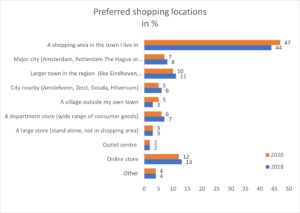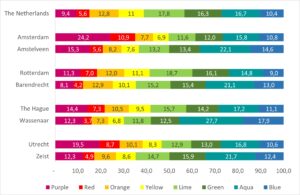30 januari
The corona pandemic has clearly changed the way consumers shop. In Holland, the PBL expects vacancy to increase by about 40% in the coming years. It is therefore very important to consider the new role of town centres in the post corona era. In the first instance, it is now up to the municipalities to take the lead, by revising town-centre plans and defining a strategy for reviving retail locations. It is essential to start from a consumer perspective, because lifestyles can clearly differ from town to town. As a result, we create interesting and distinctive inner cities, which also match the identity of the local community.
By Andre Doffer and Herman Kok
Local authorities, landlords, and retailers are triggered to rethink the relevance of individual locations in the context of a changing retail landscape. Retail is in turmoil across Europe. Covid-19 has further pinpointed structural problems affecting the sector:
- an accelerated shift of trade to the online sales channel,
- further pressure on rent collection rates,
- increasing vacancy,
- and the future of retail locations being challenged.
Starting point for repositioning locations is the perspective of the consumer as end-user of these locations. DISCvision lifestyles helps to unravel patterns of lifestyles and identities in individual catchment areas.
Vacancy in highstreets and shopping centres is expected to increase in the coming years. According to PBL (Netherlands Environmental Assessment Agency) and Locatus, retail vacancy is to increase by 40% in the larger city centre highstreet areas as impact of Covid-19 in the coming two years (PBL publication 4288, December 2020). According to Slob (Locatus), the average national vacancy increase will be less dramatic as the vacancy increase in convenience shopping centres, the dominant type of shopping centres in the Netherlands, will be less pronounced.
While 2020 was on average not a too bad year for retail sales, the picture is highly polarised between the various sub-sectors. Sectors like grocery, diy do-it-yourself, electronics, and sports and leisure did very well, taking advantage of the closure of gastronomy, and restrictions on travelling and attending events. But sectors like fashion, shoes & leather, and accessories, typically located in highstreet areas, have had a difficult trade year so far. Working from home and lack of opportunities to socialise impacted the demand for new formal clothing substantially.
The 2020 seasonal period will be critical for many retailers. It is the November and December period connected to Saint Nicholas and Christmas in which non-food retailers make a good share of their annual turnover. Sales indices for the fourth quarter compared to an average quarter are for instance 112 for clothing, 120 for consumer electronics, and 163 for toys sales (Statistics Netherlands (CBS), edited by DISCvision). A disappointing 2020 Q4 combined with a termination of Covid-related support policies and banks reconsidering their finance strategies might be a final push for a good number of retailers to file for administration. Given the polarised performance in the retail sector with fashion retailers hit most strongly, it is therefore no surprise that town centre highstreet areas are expected to be impacted the most.
On the other hand, Covid-19 emphasized the resilience of proximity convenience locations, combined with a preference for shopping on a nearby and easily accessible location rather than a shopping trip to one of the largest and busiest shopping destinations. Whether the latter trend is structural is to be seen, but it connects well to the ‘re-urbanisation of third tier cities’ thesis in response of the largest cities having more complexities to come to a Corona-proof urban model.

Source: Retail outlook ABN-AMRO, october 2020
For retailers and landlords, the fall-out of Covid-19 offers the opportunity to take tough decisions on restructuring and strategic change, to prepare the operations for a post-Covid-19 future. This will affect retail locations and may challenge the retail hierarchy we are used to. For municipalities and regional authorities high time to rethink their retail visions. In most cases, retail locations are much more than locations to buy or shop. These locations often bring identity to their localities and have the potential to function as “heart of the neighbourhood” or “heart of the town”
where people come together, socialise, and interact with the community. Market places, town centres, and neighbourhood quarters are as old as cities are. Functions and appearances changed, but its role in the urban fabric remained the same and deserve attention from all stakeholders to upkeep their function in a rapidly changing urban context.
It is therefore surprising that only 58% of all municipalities in the Netherlands foresee an update of their retail vision, of which only 41%, so slightly more than 24% of the total, anticipates an update in the short term (report “Impact analyses retail post corona”, July 2020, NRW INretail e.o.). Issues to work on include:
- How to consolidate town centre highstreet areas into viable entities comprising A, B, and C zones without substantial gaps
- How to maintain an environment in which young and innovative retailers can flourish
- How to combine retail with other social and cultural functions to maintain the concept of a vibrant marketplace
- How to transform “neighbourhood centres” into “hearts of the neighbourhoods” by bringing them up to date, making them generation proof in an ageing catchment context, and enriching the variety of functions including residential to transform the area into a neighbourhood heart
Given the duration of political and planning processes, as well as complex negotiations with stakeholders, the timing of rethinking retail locations is essential to take as much advantage as possible from the current Covid-19 fallout. There is ample time, and the importance of an attractive centre area with a well-balanced combination of commercial, cultural and social functions is of vital importance for the future of local communities.
For a successful transformation from “neighbourhood centres” to “the heart of the neighbourhood”, it is essential to take the perspective of the consumer as starting point. What is the culture and identity of a neighbourhood, and which retail and social facilities are best suited to this? In the Netherlands, DISCvision has a database in which the lifestyle profile of households is known at street level. The differences this leads to for a number of large cities in the Netherlands and the surrounding towns are shown in the figure below.

DISCvision lifestyles for four major cities in the Netherlands compared to suburban towns in their agglomeration with very different lifestyles. Neighbourhoods within cities vary in the same way from each other as these smaller towns from the major city. This shows the need for tailor made planning of retail, cultural or social functions.
Rethinking retail locations will become even more urgent as Covid-19 might be the accelerator by which landlords and retailers will be enabled to rethink their positions and business models. So far, leasing models have been predominantly based on fixed base rents defined in long term contracts. Base rents which have been rising steadily until a few years ago but are in the context of the ongoing retail transformation increasingly under pressure. 2021 might be the year in which landlords and retailers make a first step to a new leasing model relying more on the exchange of performance indicators and more flexible contracts.
This will generate challenges and opportunities for individual retail locations which municipalities may want to rely on in their retail views.
Covid-19 contributed to an accelerated transformation in the retail sector accompanied by a further shift in sales channels toward online. The trend to repurpose vacant retail space into new functions like residential, workspaces or services will therefore get into a higher gear as well. This implies a growing responsibility for municipal authorities to define a vision and strategy to accommodate these rapidly changing dynamics. For municipalities, as well as for landlords and developers, it is crucial to take the perspectives and preferences of consumers as starting point. This will provide a view on how varieties in identity and lifestyles affect the optimal positioning of centre areas and the possibilities to create value.
Download pdf







